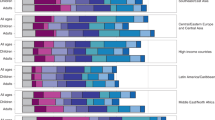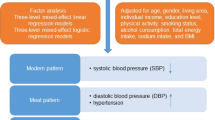Abstract
Background and aims
A healthy diet is the cornerstone of disease prevention, and dietary guidelines have been issued in most countries. We aimed to assess trends in compliance with dietary guidelines in the population of Geneva, Switzerland.
Methods
Multiple cross-sectional, population-based surveys conducted between 1993 and 2016 in the canton of Geneva, Switzerland [20,310 participants (52.3% women, mean age 51.9 ± 10.7 years)]. Trends in compliance with the Swiss dietary guidelines regarding food intake were assessed using logistic regression (a) for each guideline and (b) for at least three guidelines. Compliance before and after the first and second issuing of the guidelines was assessed.
Results
After multivariable adjustment, compliance with fruits increased overall [odds ratio and (95% confidence interval) for 1-year increase: 1.007 (1.003–1.012), p < 0.001], in men, participants aged over 45 and with low educational level. Compliance with vegetables increased overall [1.015 (1.008–1.022), p < 0.001], in both genders, age groups [45–54 and 55–64] and participants with low educational level. Compliance with meat increased in women [1.007 (1.001–1.013), p = 0.021] and participants with a university degree. Compliance with fresh fish increased in age group [55–64] [1.009 (1.000–1.018), p = 0.041]. Compliance with dairy products decreased overall [0.979 (0.972–0.986), p < 0.001] and in all groups studied, except for age group [65–74]. Compliance with at least three guidelines increased in age group [55–64] only [1.013 (1.002–1.024), p = 0.019]. No effect of the issuing of the guidelines was found.
Conclusion
In the Geneva adult population, compliance with the Swiss dietary guidelines improved little. Issuing of dietary guidelines did not impact trends.
This is a preview of subscription content, access via your institution
Access options
Subscribe to this journal
Receive 12 print issues and online access
$259.00 per year
only $21.58 per issue
Buy this article
- Purchase on Springer Link
- Instant access to full article PDF
Prices may be subject to local taxes which are calculated during checkout
Similar content being viewed by others
References
World Health Organization. Diet, nutrition and the prevention of chronic diseases. A report of the WHO Study Group on Diet, Nutrition and Prevention of Noncommunicable Diseases. Nutr Rev. 1991;49:291–301.
World Health Organization, Food and Agriculture Organization of the United Nations. Preparation and use of food-based dietary guidelines. Report of a joint FAO/WHO consultation. FAO/WHO.World Health Organ Tech Rep Ser,1998:880:1-108
Montagnese C, Santarpia L, Buonifacio M, Nardelli A, Caldara AR, Silvestri E, et al. European food-based dietary guidelines: a comparison and update. Nutrition. 2015;31:908–15. https://doi.org/10.1016/j.nut.2015.01.002
Montagnese C, Santarpia L, Iavarone F, Strangio F, Caldara AR, Silvestri E, et al. North and South American countries food-based dietary guidelines: A comparison. Nutrition. 2017;42:51–63. https://doi.org/10.1016/j.nut.2017.05.014
Société Suisse de nutrition [Swiss nutrition society]. Pyramide alimentaire suisse. Bern, Switzerland, 2017.
Schmidhuber J, Traill WB. The changing structure of diets in the European Union in relation to healthy eating guidelines. Public Health Nutr. 2006;9:584–95.
Verly Junior E, Carvalho AM, Fisberg RM, Marchioni DM. [Adherence to the food guide for the Brazilian population]. Rev Saude Publica. 2013;47:1021–7.
Haack SA, Byker CJ. Recent population adherence to and knowledge of United States federal nutrition guides, 1992-2013: a systematic review. Nutr Rev. 2014;72:613–26. https://doi.org/10.1111/nure.12140.
Gose M, Krems C, Heuer T, Hoffmann I. Trends in food consumption and nutrient intake in Germany between 2006 and 2012: results of the German National Nutrition Monitoring (NEMONIT). Br J Nutr. 2016;115:1498–507. https://doi.org/10.1017/S0007114516000544.
Smith C, Gray AR, Mainvil LA, Fleming EA, Parnell WR. Secular changes in intakes of foods among New Zealand adults from 1997 to 2008/09. Public Health Nutr. 2015;18:3249–59. https://doi.org/10.1017/S1368980015000890
Makarem N, Scott M, Quatromoni P, Jacques P, Parekh N. Trends in dietary carbohydrate consumption from 1991 to 2008 in the Framingham Heart Study Offspring Cohort. Br J Nutr. 2014;111:2010–23. https://doi.org/10.1017/S0007114513004443
Park K. Trends in adherence to dietary recommendations among Korean type 2 diabetes mellitus patients. Nutr Res Pract. 2015;9:658–66. https://doi.org/10.4162/nrp.2015.9.6.658
Office fédéral de la sécurité alimentaire et des affaires vétérinaires. Savourer les repas et rester en bonne santé.. In: Stratégie suisse de nutrition 2017–2024. Berne; 2017.
de Abreu D, Guessous I, Gaspoz JM, Marques-Vidal P. Compliance with the Swiss Society for Nutrition’s dietary recommendations in the population of Geneva, Switzerland: a 10-year trend study (1999-2009). J Acad Nutr Diet. 2014;114:774–80. https://doi.org/10.1016/j.jand.2013.07.032
Lutsey PL, Steffen LM, Stevens J. Dietary intake and the development of the metabolic syndrome: the Atherosclerosis Risk in Communities study. Circulation. 2008;117:754–61. https://doi.org/10.1161/circulationaha.107.716159
Stanner SA, Hughes J, Kelly CN, Buttriss J. A review of the epidemiological evidence for the ‘antioxidant hypothesis’. Public Health Nutr. 2004;7:407–22.
Hu FB, Willett WC. Optimal diets for prevention of coronary heart disease. JAMA. 2002;288:2569–78.
Sala-Vila A, Estruch R, Ros E. New insights into the role of nutrition in CVD prevention. Curr Cardiol Rep. 2015;17:26 https://doi.org/10.1007/s11886-015-0583-y
Wikipedia. Canton of Geneva. In. San Francisco, CA, USA: Wikimedia foundation, 2018. https://en.wikipedia.org/wiki/Canton_of_Geneva
Morabia A, Bernstein M, Heritier S, Ylli A. Community-based surveillance of cardiovascular risk factors in Geneva: methods, resulting distributions, and comparisons with other populations. Prev Med. 1997;26:311–9. https://doi.org/10.1006/pmed.1997.0146
Bernstein L, Huot I, Morabia A. Amélioration des performances d’un questionnaire alimentaire semi-quantitatif comparé à un rappel des 24 heures. St Publique. 1995;7:403–13.
Beer-Borst S, Costanza MC, Pechère-Bertschi A, Morabia A. Twelve-year trends and correlates of dietary salt intakes for the general adult population of Geneva, Switzerland. Eur J Clin Nutr. 2009;63:155–64. https://doi.org/10.1038/sj.ejcn.1602922
Singh GM, Micha R, Khatibzadeh S, Lim S, Ezzati M, Mozaffarian D. et al. Estimated global, regional, and national disease burdens related to sugar-sweetened beverage consumption in 2010. Circulation. 2015;132:639–66. https://doi.org/10.1161/CIRCULATIONAHA.114.010636
Mozaffarian D, Fahimi S, Singh GM, Micha R, Khatibzadeh S, Engell RE. et al. Global sodium consumption and death from cardiovascular causes. N Engl J Med. 2014;371:624–34. https://doi.org/10.1056/NEJMoa1304127
Nahab F, Pearson K, Frankel MR, Ard J, Safford MM, Kleindorfer D, et al. Dietary fried fish intake increases risk of CVD: the REasons for geographic and racial differences in stroke (REGARDS) study. Public Health Nutr. 2016;19:3327–36. https://doi.org/10.1017/S136898001600152X
Gadiraju TV, Patel Y, Gaziano JM, Djousse L. Fried food consumption and cardiovascular health: a review of current evidence. Nutrients. 2015;7:8424–30. https://doi.org/10.3390/nu7105404
Schneid Schuh D, Campos Pellanda L, Guessous I, Marques-Vidal P. Trends and determinants of change in compliance to dietary guidelines in a Swiss community-dwelling sample. Prev Med. 2018;111:198–203. https://doi.org/10.1016/j.ypmed.2018.03.008
Dubuisson C, Lioret S, Touvier M, Dufour A, Calamassi-Tran G, Volatier JL, et al. Trends in food and nutritional intakes of French adults from 1999 to 2007: results from the INCA surveys. Br J Nutr. 2010;103:1035–48. https://doi.org/10.1017/S0007114509992625
Guerra F, Paccaud F, Marques-Vidal P. Trends in food availability in Switzerland, 1961-2007. Eur J Clin Nutr. 2012;66:273–5. https://doi.org/10.1038/ejcn.2011.187
Food and Agricultural Organization. Food balance sheets. Rome, Italy: Food and Agricultural Organization; 2018.
Swiss federal Office of Statistics. Agriculture and food: pocket statistics 2018. Neuchâtel, Switzerland: Agriculture et alimentation - statistique de poche 2018; 2018.
Suisse Romande. Faire ses courses en France, un vrai bon plan? Môtiers, Switzerland: Chocolat TV productions SàRL; 2017.
Tunick MH, Van Hekken DL. Dairy products and health: recent insights. J Agric Food Chem. 2015;63:9381–8. https://doi.org/10.1021/jf5042454
Rice BH, Quann EE, Miller GD. Meeting and exceeding dairy recommendations: effects of dairy consumption on nutrient intakes and risk of chronic disease. Nutr Rev. 2013;71:209–23. https://doi.org/10.1111/nure.12007
Schmid A, Gille D, Piccinali P, Butikofer U, Chollet M, Altintzoglou T, et al. Factors predicting meat and meat products consumption among middle-aged and elderly people: evidence from a consumer survey in Switzerland. Food Nutr Res. 2017;61:1308111 https://doi.org/10.1080/16546628.2017.1308111
Djousse L, Akinkuolie AO, Wu JH, Ding EL, Gaziano JM. Fish consumption, omega-3 fatty acids and risk of heart failure: a meta-analysis. Clin Nutr. 2012;31:846–53. https://doi.org/10.1016/j.clnu.2012.05.010
Schwingshackl L, Schwedhelm C, Hoffmann G, Lampousi AM, Knuppel S, Iqbal K, et al. Food groups and risk of all-cause mortality: a systematic review and meta-analysis of prospective studies. Am J Clin Nutr. 2017;105:1462–73. https://doi.org/10.3945/ajcn.117.153148
Mozaffarian D, Bryson CL, Lemaitre RN, Burke GL, Siscovick DS. Fish intake and risk of incident heart failure. J Am Coll Cardiol. 2005;45:2015–21. https://doi.org/10.1016/j.jacc.2005.03.038
Cahill LE, Pan A, Chiuve SE, Sun Q, Willett WC, Hu FB. et al. Fried-food consumption and risk of type 2 diabetes and coronary artery disease: a prospective study in 2 cohorts of US women and men. Am J Clin Nutr. 2014;100:667–75. https://doi.org/10.3945/ajcn.114.084129
Guallar-Castillon P, Rodriguez-Artalejo F, Lopez-Garcia E, Leon-Munoz LM, Amiano P, Ardanaz E. et al. Consumption of fried foods and risk of coronary heart disease: Spanish cohort of the European Prospective Investigation into Cancer and Nutrition study. BMJ. 2012;344:e363 https://doi.org/10.1136/bmj.e363
de Mestral C, Khalatbari-Soltani S, Stringhini S, Marques-Vidal P. Fifteen-year trends in the prevalence of barriers to healthy eating in a high-income country. Am J Clin Nutr. 2017;105:660–8. https://doi.org/10.3945/ajcn.116.143719
de Mestral C, Stringhini S, Marques-Vidal P. Barriers to healthy eating in Switzerland: a nationwide study. Clin Nutr. 2016;35:1490–8. https://doi.org/10.1016/j.clnu.2016.04.004
Marques-Vidal P, Vollenweider P, Grange M, Guessous I, Waeber G. Patients with dyslipidemia on a self-reported diet have a healthier dietary intake than the general population. The CoLaus study. Clin Nutr ESPEN. 2016;11:e33–9. https://doi.org/10.1016/j.clnesp.2015.11.003
Marques-Vidal P, Vollenweider P, Grange M, Guessous I, Waeber G. Dietary intake of subjects with diabetes is inadequate in Switzerland: the CoLaus study. Eur J Nutr. 2017;56:981–9. https://doi.org/10.1007/s00394-015-1146-0
Grange M, Mayen AL, Guessous I, Waeber G, Vollenweider P, Marques-Vidal P. Lost in translation: dietary management of cardiovascular risk factors is seldom implemented. Prev Med. 2015;76:68–73. https://doi.org/10.1016/j.ypmed.2015.03.024
Waterlander WE, de Boer MR, Schuit AJ, Seidell JC, Steenhuis IH. Price discounts significantly enhance fruit and vegetable purchases when combined with nutrition education: a randomized controlled supermarket trial. Am J Clin Nutr. 2013;97:886–95. https://doi.org/10.3945/ajcn.112.041632
Ni Mhurchu C, Blakely T, Jiang Y, Eyles HC, Rodgers A. Effects of price discounts and tailored nutrition education on supermarket purchases: a randomized controlled trial. Am J Clin Nutr. 2010;91:736–47. https://doi.org/10.3945/ajcn.2009.28742
Sangita S, Vik SA, Pakseresht M, Kolonel LN. Adherence to recommendations for fruit and vegetable intake, ethnicity and ischemic heart disease mortality. Nutr Metab Cardiovasc Dis. 2013;23:1247–54. https://doi.org/10.1016/j.numecd.2013.03.004
Chatelan A, Beer-Borst S, Randriamiharisoa A, Pasquier J, Blanco JM, Siegenthaler S et al. Major differences in diet across three linguistic regions of Switzerland: results from the first national nutrition survey menuCH. Nutrients 2017;9. https://doi.org/10.3390/nu9111163
Nutrition and Food Security Programme, WHO Regional Office for Europe. Food-based dietary guidelines in the WHO European region: Copenhagen, Denmark, World Health Organization, 2003.
Funding:
The Bus Santé study is funded by the University Hospitals of Geneva and the General Directorate of Health, Canton of Geneva, Switzerland.
Author information
Authors and Affiliations
Corresponding author
Ethics declarations
Conflict of interest
The authors declare that they have no conflict of interest.
Electronic supplementary material
Rights and permissions
About this article
Cite this article
Schneid Schuh, D., Guessous, I., Gaspoz, JM. et al. Twenty-four-year trends and determinants of change in compliance with Swiss dietary guidelines. Eur J Clin Nutr 73, 859–868 (2019). https://doi.org/10.1038/s41430-018-0273-0
Received:
Revised:
Accepted:
Published:
Issue Date:
DOI: https://doi.org/10.1038/s41430-018-0273-0
This article is cited by
-
Distinguishing inter- and pangenerational food trends
Agricultural and Food Economics (2023)



